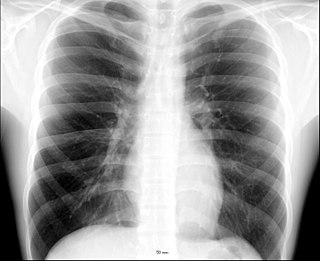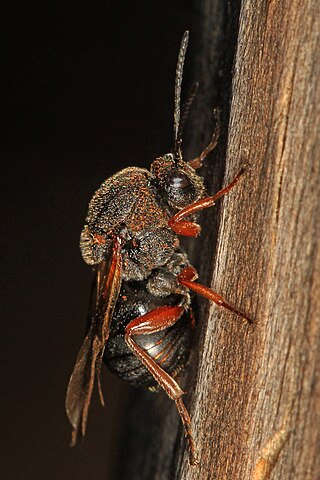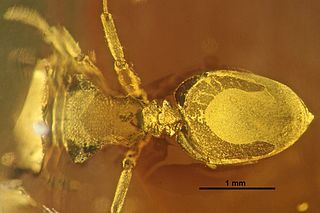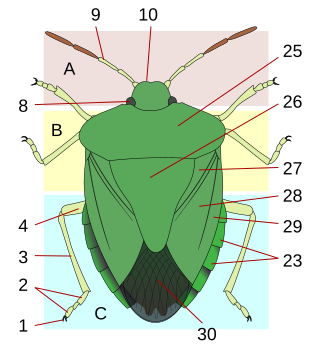
The thorax or chest is a part of the anatomy of mammals and other tetrapod animals located between the neck and the abdomen. In insects, crustaceans, and the extinct trilobites, the thorax is one of the three main divisions of the creature's body, each of which is in turn composed of multiple segments.

Apocrita is a suborder of insects in the order Hymenoptera. It includes wasps, bees, and ants, and consists of many families. It contains the most advanced hymenopterans and is distinguished from Symphyta by the narrow "waist" (petiole) formed between the first two segments of the actual abdomen; the first abdominal segment is fused to the thorax, and is called the propodeum. Therefore, it is general practice, when discussing the body of an apocritan in a technical sense, to refer to the mesosoma and metasoma rather than the "thorax" and "abdomen", respectively. The evolution of a constricted waist was an important adaption for the parasitoid lifestyle of the ancestral apocritan, allowing more maneuverability of the female's ovipositor. The ovipositor either extends freely or is retracted, and may be developed into a stinger for both defense and paralyzing prey. Larvae are legless and blind, and either feed inside a host or in a nest cell provisioned by their mothers.

Gall wasps, also traditionally calledgallflies, are hymenopterans of the family Cynipidae in the wasp superfamily Cynipoidea. Their common name comes from the galls they induce on plants for larval development. About 1,300 species of this generally very small creature are known worldwide, with about 360 species of 36 different genera in Europe and some 800 species in North America.

This glossary of entomology describes terms used in the formal study of insect species by entomologists.
The metathorax is the posterior of the three segments in the thorax of an insect, and bears the third pair of legs. Its principal sclerites are the metanotum (dorsal), the metasternum (ventral), and the metapleuron (lateral) on each side. The metathorax is the segment that bears the hindwings in most winged insects, though sometimes these may be reduced or modified, as in the flies (Diptera), in which they are reduced to form halteres, or flightless, as in beetles (Coleoptera), in which they may be completely absent even though forewings are still present. All adult insects possess legs on the metathorax. In most groups of insects, the metanotum is reduced relative to the mesonotum. In the suborder Apocrita of the Hymenoptera, the first abdominal segment is fused to the metathorax, and is then called the propodeum.

The metasoma is the posterior part of the body, or tagma, of arthropods whose body is composed of three parts, the other two being the prosoma and the mesosoma. In insects, it contains most of the digestive tract, respiratory system, and circulatory system, and the apical segments are typically modified to form genitalia. In a few of the most primitive insects, the metasomal segments bear small, articulated appendages called "styli", which are often considered to be vestigial. There are also pre-apical appendages in most insect orders, called cerci, which may be multi-segmented and almost resembling a posterior pair of antennae; these may be variously modified, or lost entirely. Otherwise, most adult insects lack appendages on the metasoma, though many larval insects have some form of appendages, such as prolegs or, in aquatic insects, gills.

Nesagapostemon is an extinct monotypic genus of sweat bee in the Halictidae subfamily Halictinae. At present, it contains the single species Nesagapostemon moronei.
Eickwortapis is an extinct monotypic genus of sweat bee in the Halictidae subfamily Halictinae which contains the single species Eickwortapis dominicana.
Strumigenys hispida is a species of yellow ant up to 3 mm in length. It is endemic to Taiwan.

Cephalotes hispaniolicus is an extinct species of ant in the subfamily Myrmicinae known from a single Middle Miocene fossil found in amber on Hispaniola. At the time of description C. hispaniolicus was one of six ant species placed in the Cephalotesmultispinosus clade.

The thorax is the midsection (tagma) of the hexapod body. It holds the head, legs, wings and abdomen. It is also called mesosoma or cephalothorax in other arthropods.

Megaphragma is a genus of wasp in the family Trichogrammatidae. It contains some of the smallest known insects, Megaphragma caribea and Megaphragma mymaripenne, which are roughly the same size as some unicellular protozoans.

Aphaenogaster amphioceanica is an extinct species of ant in the subfamily Myrmicinae known from a single possibly Miocene fossil found in amber on Hispaniola. At the time of description A. amphioceanica was one of two Aphaenogaster species known from the Caribbean islands.

Yantaromyrmex is an extinct genus of ants first described in 2013. Members of this genus are in the subfamily Dolichoderinae of the family Formicidae, known from Middle Eocene to Early Oligocene fossils found in Europe. The genus currently contains five described species, Y. constrictus, Y. geinitzi, Y. intermedius, Y. mayrianum and Y. samlandicus. The first specimens were collected in 1868 and studied by Austrian entomologist Gustav Mayr, who originally placed the fossils in other ant genera until the fossils were reviewed and subsequently placed into their own genus. These ants are small, measuring from 4 to 6 mm in length and can be characterized by their trapezoidal shaped head-capsules and oval compound eyes that are located slightly to the rear of the capsules midpoint, with no known ocelli present.

Anomalon cruentatum is a species of parasitoid wasps belonging to the family Ichneumonidae.
Sapyga louisi is a species of a club-horned wasp in the family – Sapygidae. Adults feed from flowers and the larvae are kleptoparasites of leaf cutter bee larvae, including those of Heriades carinata.
Dusona abdominator is a species of parasitic wasp belonging to the family Ichneumonidae, subfamily Campopleginae.

Dusona leptogaster is a species of parasitic wasp belonging to the family Ichneumonidae, subfamily Campopleginae. It is a parasitoid of Geometrid moth larvae, the two known hosts being Alsophila aescularia and Lomaspilis marginata.

Callidora is a genus of parasitoid wasps belonging to the family Ichneumonidae and the subfamily Campopleginae. It is relatively species poor, with only five recognized species.
Aiura is a genus of parasitoid wasps belonging to the family Ichneumonidae and the subfamily Campopleginae.














